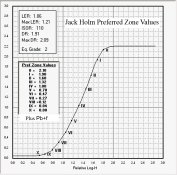Stephen Benskin
Member
I interpret the same Zone VIII density. But I used the Contrast Index meter overlay to read CI from my hand-drawn chart where I transcribed the numbers. I see Ansel Adams didn't subtract Base plus Fog from the graphs, and when I came up with the lower CI, I had set the Contrast Index meter overlay on baseline zero. When I lift the CI meter to about 0.05 density (which is where I believe his Normal curve would zero out), I get close to 0.57 CI like you do.
I agree, Delta-X criterion justifies holding the same speed rating (so I will not include this specific 1/6 stop adjustment in my own personal EI), but most Zone System EI are taken from the 0.1 density mark, and that would definitely move for people reading Zone System tests.
The reason for working out factors of 1/6 stop is not to achieve a false sense of precision... I would round to the nearest 1/3 stop. For now, for me, that is 2/3 stop.
I just wanted to remind you that because of Deltx-X, the CI comparison wasn't apples to apples. The consistency of speeds using under Delta-X brings into question the need for testing.












